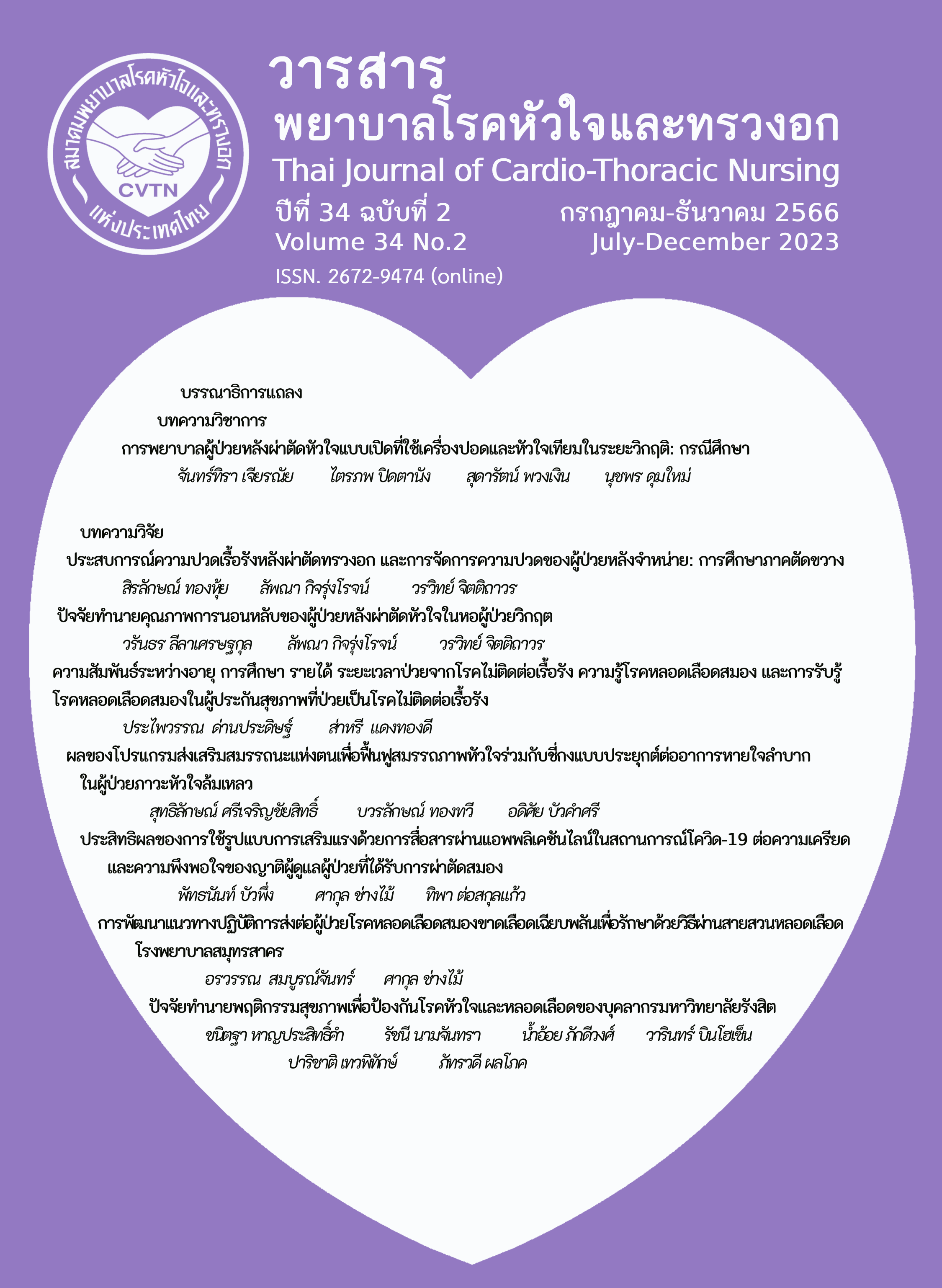ความสัมพันธ์ระหว่างอายุ การศึกษา รายได้ ระยะเวลาป่วยจาก โรคไม่ติดต่อเรื้อรัง ความรู้โรคหลอดเลือดสมอง และการรับรู้ โรคหลอดเลือดสมองในผู้ประกันสุขภาพที่ป่วยเป็นโรคไม่ติดต่อเรื้อรัง
คำสำคัญ:
การรับรู้โรคหลอดเลือดสมอง, ความรู้โรคหลอดเลือดสมอง, ผู้ประกันสุขภาพ, โรคไม่ติดต่อเรื้อรังบทคัดย่อ
การศึกษาเชิงพรรณนาครั้งนี้ เพื่อศึกษาความสัมพันธ์ระหว่างอายุ การศึกษา รายได้ ระยะเวลาป่วยจากโรคไม่ติดต่อเรื้อรัง ความรู้โรคหลอดเลือดสมองและการรับรู้โรคหลอดเลือดสมองในผู้ประกันสุขภาพที่ป่วยเป็นโรคไม่ติดต่อเรื้อรัง กลุ่มตัวอย่าง คือ ผู้ประกันสุขภาพที่ป่วยเป็นโรคไม่ติดต่อเรื้อรัง โรงพยาบาลเอกชนแห่งหนึ่ง ในจังหวัดสมุทรสาคร เลือกแบบเฉพาะเจาะจง (purposive sampling) จำนวน 326 คน เก็บข้อมูลด้วยแบบสอบถามการรับรู้ปัจจัยเสี่ยงโรคหลอดเลือดสมอง การรับรู้อาการเตือนของสมองขาดเลือด การรับรู้สัญญาณอันตรายของสมองขาดเลือด และความรู้โรคหลอดเลือดสมอง วิเคราะห์ข้อมูลโดยการใช้สถิติพรรณนา และสัมประสิทธิ์สหสัมพันธ์ของเพียร์สัน
ผลการวิจัยพบว่า กลุ่มตัวอย่างเป็นผู้ป่วยโรคความดันโลหิตสูง ร้อยละ 42.94 มีการรับรู้โรคหลอดเลือดสมองโดยรวมอยู่ในระดับปานกลาง (Mean=13.23, SD=2.10) การศึกษา มีความสัมพันธ์ทางลบในระดับต่ำกับการรับรู้โรคหลอดเลือดสมอง อย่างมีนัยสำคัญทางสถิติที่ระดับ 0.01 (r = -0.25, p < 0.01) และความรู้โรคหลอดเลือดสมองมีความสัมพันธ์ทางบวกในระดับต่ำกับการรับรู้โรคหลอดเลือดสมอง อย่างมีนัยสำคัญทางสถิติที่ระดับ 0.01 (r = 0.19, p < 0.01)
ผลจากการศึกษาเสนอแนะว่าทีมสุขภาพจำเป็นต้องส่งเสริมการรับรู้โรคหลอดเลือดสมองให้กับผู้ประกันสุขภาพโดยใช้โปรแกรมและนวัตกรรมที่ทันสมัย เพื่อเพิ่มการเรียนรู้และการรับรู้โรคหลอดเลือดสมอง
เอกสารอ้างอิง
Prasat Neurological Institute of Thailand. Care map for Hemorrhagic stroke. Department of Medical Services, Ministry of Public Health. Pathumthani: Tana Press Company Limited; 2016.p.3-12. (in Thai).
Division of Non-Communicable Diseases. Number and death rate from 5 non-communicable diseases (2017 - 2021). [document on the Internet] 2020 [cited 2020 Jan 13]. Available from: http://www.thaincd. com/ 2016/ mission/documents-etail.php?id=14480&tid=32&gid=1-020 (in Thai).
National Institute for Emergency Medicine. Guidelines for following the announcement of the emergency medical committee, subject: criteria and conditions regarding performance of duties and supervision of operating units medicine 2021. [document on the Internet] 2021 [cited 2023 Jan 18]. Available from: https://www.niems.go.th/1/UploadAttachFile/2023/EBook/416932_20230810140855.pdf (in Thai).
National Institute for Emergency Medicine. Stroke disease, knowledge for the people. Bangkok: Ultimate Printing CO., LTD; 2021. [document on the Internet] 2021 [cited 2023 Jan 18]. Available from:https://www.niems. go.th/1/UploadAttachFile/2021/EBook/413539_20210902084924.pdf (in Thai).
Faculty of Medicine, Chulalongkorn University. Chulalongkorn Stroke Center of Excellence. [Internet] 2021 [cited 2023 Oct 18]. Available from:https://chulalongkornhospital.go.th /kcmh/ec/ศูนย์ความเป็นเลิศทางก-20/ (in Thai).
Division of Medical Technical and Academic Affairs. Handbook of integrated, people-centered health services in new normal diabetic & hypertension clinic (for healthcare workers). Department of Medical Services, Ministry of Public Health. Bangkok: Printing Office Veterans Welfare Organization; 2020. (in Thai).
Division of Noncommunicable Diseases. Announcing results of innovations in the use of digital technology for patients with diabetes and high blood pressure, Round Department of Disease Control. Ministry of Public Health. [document on the Internet] 2023 [cited 2023 November 20]. Available from: http://www.thaincd.com/images/PRNCD/OUT/servicemodel_รอบที่1.65.pdf (in Thai).
Korjedee P, Kittiboonthawal P. Namdej N, Chunchum J. A predictive factor of the knowledge levels with stroke risk factors and warning signs in Saraburi community people. Nursing Journal of the Ministry of Public Health. 2022;32(2):65-77. (in Thai).
Sodaprom D, Wannaratvigit C. Factors Influencing Preventive Behaviors for Cerebrovascular Disease among Elderly Risk Group in the Aranyik Town Municipality,Mueang Phitsanulok District, Phitsanulok Province. Journal of Phrapokklao Nursing College.2021; 32(2):98- 111. (in Thai).
Wanna A, Kimsungnoen N, Namjuntra R. Perceptions and management of warning signs among persons at risk of stroke. APHEIT Journal of Nursing and Health. 2020; (2)1: 30-44. (in Thai).
Prachuablarp C, Wattradul D. Predicting factors of preventive behaviors of coronary heart disease and stroke among menopausal women. Thai Journal of Cardio-Thoracic Nursing. 2020;31(1):27-34. (in Thai).
Pramoolsinsup K, Sunthonanunth W, Wathananonsathean W. Perception of stroke warning sign and management among high-risk patients. Christian University of Thailand Journal. 2018;24(1):41-54.(in Thai).
Yanti N, Sirirat C. Factors associated with behaviors of stroke prevention among village health volunteers, in a sub-district, Sam Chuk District, Suphanburi Province. Journal of Safety and Health. 2018;11(2):23-32. (in Thai)
Jaipong S, Srithumsuk W. Relationship between perceived risk factors, warning signs and emergency management of stroke among village health volunteers in Phetchaburi Province. Boromarajonani College of Nursing, Uttaradit Journal. 2021; 10(2):44-56. (in Thai).
Rosenstock IM, Stretcher VL, Becker MH. Social learning theory and the health belief model. Health Education Quarterl. 1988;15(2):175-83.
Ruangchaithaweesuk K, Wongpiriyayothar A, Wongpanarak N. Factors predicting stroke prevention behaviors in patients at risk of stroke. TRC Nurs J. 2021;14(1):213-25. (in Thai).
Siriraj Stroke Center. Current situation of cerebrovascular disease. Siriraj Hospital [internet] 2021 [cited 2023 Jan 13]. Available from: https://www.si.mahidol.ac.th/sidoctor/e- pl/admin/article_files/1256_1.pdf (in Thai).
Bumrungrad Hospital. Cerebrovascular disease. [homepage on the Internet] 2019 [cited 2023 Jan 11]. Available from: https://www.bumrungrad.com/th/conditions/ stroke. (in Thai).
Nilanon Y. Paresis, Paralysis, chronic diseases, need to take care of. Department of Internal Medicine, Faculty Siriraj Hospital Medicine. [homepage on the Internet] 2019 [cited 2023 Jan 12]. Available from: https://www.si.mahidol. ac.th/sidoctor/e-pl/articledetail.asp?id=707. (in Thai).
Prasat Neurological Institute of Thailand. Guidelines for nursing stroke patients for general nurses. Bangkok: Tana Press Company Limited; 2016.
Faul F, Erdfelder E, Lang AG, Buchner A. G*Power 3: a flexible statistical power analysis program for the social, behavioral, and biomedical sciences. Behavior Research Method. 2007;39:175-91.
Best JW. Research in education. 3rd ed. Englewood Cliffs, New Jersey: Prentice-Hall; 1977.
Srisatidnarakul B. The Methodology in Nursing. Bangkok: U & I Inter Media Co., Ltd; 2017. p.454-77. (in Thai)
Khumros W, Ekpreechakul T. Cerebrovascular disease, risk factors, and quality of life: a systematic review. Chula Med Bull. 2019; 1(5):473–87. (in Thai)
Thepkhayan P. Perceptions, understanding, and behavior of NIDA staff toward the policy on operational excellence. Full research report. Bangkok: National Institute of Development Administration NIDA; 2023. (in Thai).
Vutiso P, Lalun A. Factors influencing stroke prevention behavior in patients with chronic disease. Thai Stroke Soc. 2022; 21(3):5-18. (in Thai).
ดาวน์โหลด
เผยแพร่แล้ว
รูปแบบการอ้างอิง
ฉบับ
ประเภทบทความ
สัญญาอนุญาต
ลิขสิทธิ์ (c) 2024 วารสารพยาบาลโรคหัวใจและทรวงอก

อนุญาตภายใต้เงื่อนไข Creative Commons Attribution-NonCommercial-NoDerivatives 4.0 International License.
บทความนี้ยังไม่เคยตีพิมพ์หรืออยู่ในระหว่างส่งไปตีพิมพ์ในวารสารอื่น ๆ มาก่อน และกองบรรณาธิการขอสงวนสิทธิ์ในการตรวจทาน และแก้ไขต้นฉบับตามเกณฑ์ของวารสาร ในกรณีที่เรื่องของท่านได้ได้รับการตีพิมพ์ในวารสารฉบับนี้ถือว่าเป็น ลิขสิทธิ์ของวารสารพยาบาลโรคหัวใจและทรวงอก






